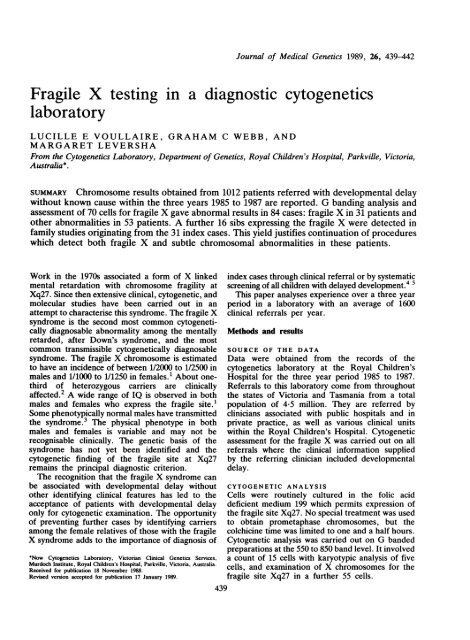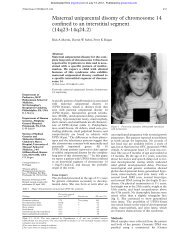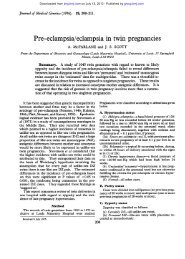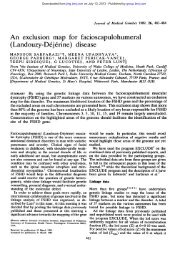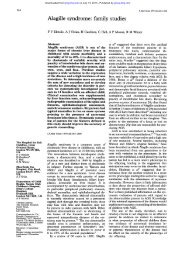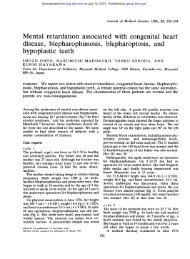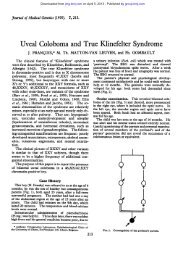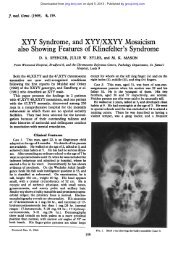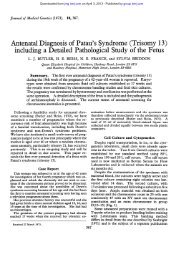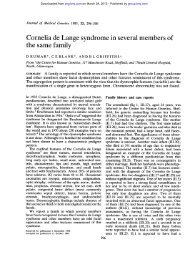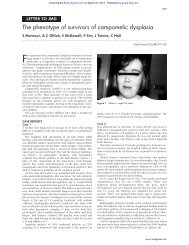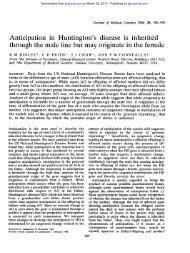Fragile X testing in a diagnostic cytogenetics laboratory - Journal of ...
Fragile X testing in a diagnostic cytogenetics laboratory - Journal of ...
Fragile X testing in a diagnostic cytogenetics laboratory - Journal of ...
Create successful ePaper yourself
Turn your PDF publications into a flip-book with our unique Google optimized e-Paper software.
<strong>Journal</strong> <strong>of</strong> Medical Genetics 1989, 26, 439-442<br />
<strong>Fragile</strong> X <strong>test<strong>in</strong>g</strong> <strong>in</strong> a <strong>diagnostic</strong> <strong>cytogenetics</strong><br />
<strong>laboratory</strong><br />
LUCILLE E VOULLAIRE, GRAHAM C WEBB, AND<br />
MARGARET LEVERSHA<br />
From the Cytogenetics Laboratory, Department <strong>of</strong> Genetics, Royal Children's Hospital, Parkville, Victoria,<br />
Australia*.<br />
SUMMARY Chromosome results obta<strong>in</strong>ed from 1012 patients referred with developmental delay<br />
without known cause with<strong>in</strong> the three years 1985 to 1987 are reported. G band<strong>in</strong>g analysis and<br />
assessment <strong>of</strong> 70 cells for fragile X gave abnormal results <strong>in</strong> 84 cases: fragile X <strong>in</strong> 31 patients and<br />
other abnormalities <strong>in</strong> 53 patients. A further 16 sibs express<strong>in</strong>g the fragile X were detected <strong>in</strong><br />
family studies orig<strong>in</strong>at<strong>in</strong>g from the 31 <strong>in</strong>dex cases. This yield justifies cont<strong>in</strong>uation <strong>of</strong> procedures<br />
which detect both fragile X and subtle chromosomal abnormalities <strong>in</strong> these patients.<br />
Work <strong>in</strong> the 1970s associated a form <strong>of</strong> X l<strong>in</strong>ked<br />
mental retardation with chromosome fragility at<br />
Xq27. S<strong>in</strong>ce then extensive cl<strong>in</strong>ical, cytogenetic, and<br />
molecular studies have been carried out <strong>in</strong> an<br />
attempt to characterise this syndrome. The fragile X<br />
syndrome is the second most common cytogenetically<br />
diagnosable abnormality among the mentally<br />
retarded, after Down's syndrome, and the most<br />
common transmissible cytogenetically diagnosable<br />
syndrome. The fragile X chromosome is estimated<br />
to have an <strong>in</strong>cidence <strong>of</strong> between 1/2000 to 1/2500 <strong>in</strong><br />
males and 1/1000 to 1/1250 <strong>in</strong> females.' About onethird<br />
<strong>of</strong> heterozygous carriers are cl<strong>in</strong>ically<br />
affected.2 A wide range <strong>of</strong> IQ is observed <strong>in</strong> both<br />
males and females who express the fragile site.'<br />
Some phenotypically normal males have transmitted<br />
the syndrome.3 The physical phenotype <strong>in</strong> both<br />
males and females is variable and may not be<br />
recognisable cl<strong>in</strong>ically. The genetic basis <strong>of</strong> the<br />
syndrome has not yet been identified and the<br />
cytogenetic f<strong>in</strong>d<strong>in</strong>g <strong>of</strong> the fragile site at Xq27<br />
rema<strong>in</strong>s the pr<strong>in</strong>cipal <strong>diagnostic</strong> criterion.<br />
The recognition that the fragile X syndrome can<br />
be associated with developmental delay without<br />
other identify<strong>in</strong>g cl<strong>in</strong>ical features has led to the<br />
acceptance <strong>of</strong> patients with developmental delay<br />
only for cytogenetic exam<strong>in</strong>ation. The opportunity<br />
<strong>of</strong> prevent<strong>in</strong>g further cases by identify<strong>in</strong>g carriers<br />
among the female relatives <strong>of</strong> those with the fragile<br />
X syndrome adds to the importance <strong>of</strong> diagnosis <strong>of</strong><br />
*Now Cytogenetics Laboratory, Victorian Cl<strong>in</strong>ical Genetics Services,<br />
Murdoch Institute, Royal Children's Hospital, Parkville, Victona, Australia.<br />
Received for publication 18 November 1988.<br />
Revised version accepted for publication 17 January 1989.<br />
<strong>in</strong>dex cases through cl<strong>in</strong>ical referral or by systematic<br />
screen<strong>in</strong>g <strong>of</strong> all children with delayed development.4 5<br />
This paper analyses experience over a three year<br />
period <strong>in</strong> a <strong>laboratory</strong> with an average <strong>of</strong> 1600<br />
cl<strong>in</strong>ical referrals per year.<br />
Methods and results<br />
SOURCE OF THE DATA<br />
Data were obta<strong>in</strong>ed from the records <strong>of</strong> the<br />
<strong>cytogenetics</strong> <strong>laboratory</strong> at the Royal Children's<br />
Hospital for the three year period 1985 to 1987.<br />
Referrals to this <strong>laboratory</strong> come from throughout<br />
the states <strong>of</strong> Victoria and Tasmania from a total<br />
population <strong>of</strong> 4*5 million. They are referred by<br />
cl<strong>in</strong>icians associated with public hospitals and <strong>in</strong><br />
private practice, as well as various cl<strong>in</strong>ical units<br />
with<strong>in</strong> the Royal Children's Hospital. Cytogenetic<br />
assessment for the fragile X was carried out on all<br />
referrals where the cl<strong>in</strong>ical <strong>in</strong>formation supplied<br />
by the referr<strong>in</strong>g cl<strong>in</strong>ician <strong>in</strong>cluded developmental<br />
delay.<br />
CYTOGENETIC ANALYSIS<br />
Cells were rout<strong>in</strong>ely cultured <strong>in</strong> the folic acid<br />
deficient medium 199 which permits expression <strong>of</strong><br />
the fragile site Xq27. No special treatment was used<br />
to obta<strong>in</strong> prometaphase chromosomes, but the<br />
colchic<strong>in</strong>e time was limited to one and a half hours.<br />
Cytogenetic analysis was carried out on G banded<br />
preparations at the 550 to 850 band level. It <strong>in</strong>volved<br />
a count <strong>of</strong> 15 cells with karyotypic analysis <strong>of</strong> five<br />
cells, and exam<strong>in</strong>ation <strong>of</strong> X chromosomes for the<br />
fragile site Xq27 <strong>in</strong> a further 55 cells.<br />
439
440<br />
The <strong>cytogenetics</strong> <strong>laboratory</strong> at the Royal Children's<br />
Hospital does not carry out prenatal <strong>diagnostic</strong><br />
<strong>test<strong>in</strong>g</strong> and has a large paediatric component <strong>in</strong><br />
its work. Of 4953 subjects studied <strong>in</strong> the <strong>laboratory</strong><br />
<strong>in</strong> the three year period, 1012 patients had a<br />
provisional diagnosis that necessitated exam<strong>in</strong>ation<br />
for the fragile X. This is 20*4% <strong>of</strong> the total<br />
<strong>in</strong>vestigations. In the period 1985 to 1987 there was<br />
an <strong>in</strong>crease <strong>in</strong> the annual total number <strong>of</strong> fragile X<br />
<strong>in</strong>vestigations (<strong>in</strong>clud<strong>in</strong>g family studies), from 299 to<br />
519, represent<strong>in</strong>g an <strong>in</strong>crease from 22% to 28% <strong>of</strong><br />
the work load. This trend has cont<strong>in</strong>ued <strong>in</strong> 1988.<br />
PATIENTS EXAMINED FOR FRAGILE X<br />
A total <strong>of</strong> 1012 patients. was <strong>in</strong>vestigated and<br />
abnormal cytogenetic results were obta<strong>in</strong>ed <strong>in</strong> 8-3%<br />
(table 1); 3-1% <strong>of</strong> the patients had fragile X and<br />
5-2% had other chromosomal abnormalities.<br />
Probands exam<strong>in</strong>ed for the fragile X were divided<br />
<strong>in</strong>to two groups on the basis <strong>of</strong> the provisional<br />
diagnosis (table 1).<br />
(1) Developmental delay without major congenital<br />
abnormalities, but <strong>in</strong>clud<strong>in</strong>g patients with m<strong>in</strong>or<br />
dysmorphic features suggestive <strong>of</strong> the fragile X, that<br />
is, patients <strong>in</strong> whom it might be assumed that the<br />
cl<strong>in</strong>ician had no specific diagnosis other than fragile<br />
X <strong>in</strong> m<strong>in</strong>d (892 patients exam<strong>in</strong>ed).<br />
(2) Developmental delay/mental retardation with<br />
congenital abnormalities, that is, patients fitt<strong>in</strong>g the<br />
more traditional reasons for chromosomal referral<br />
(120 patients exam<strong>in</strong>ed).<br />
FINDINGS IN PATIENTS REFERRED WITH<br />
DEVELOPMENTAL DELAY ONLY<br />
Abnormalities other than the fragile X were found<br />
<strong>in</strong> 44 (4-9%) patients. The abnormalities <strong>in</strong>cluded<br />
TABLE 1 Cytogenetic results <strong>in</strong> patients exam<strong>in</strong>ed for fragile X.<br />
Lucille E Voullaire, Graham C Webb, and Margaret Leversha<br />
apparently balanced rearrangements (12) <strong>in</strong>clud<strong>in</strong>g<br />
<strong>in</strong>herited rearrangements (six known) and de novo<br />
rearrangements (four); unbalanced chromosomal<br />
rearrangements (22) <strong>in</strong>clud<strong>in</strong>g r<strong>in</strong>g chromosome<br />
(two), markers (three), deletions (eight), and duplications<br />
(n<strong>in</strong>e); and sex chromosome aneuploidies<br />
(10) (for list <strong>of</strong> abnormalities see appendix).<br />
Although these patients were all referred to the<br />
<strong>laboratory</strong> with a provisional diagnosis <strong>of</strong> developmental<br />
delay only, six patients were found to have<br />
significant physical abnormalities when exam<strong>in</strong>ed by<br />
our cl<strong>in</strong>ical colleagues. Even though mild dysmorphism<br />
might be observed <strong>in</strong> a patient with developmental<br />
delay, it is frequently the developmental<br />
delay that prompts the referral for cytogenetic<br />
<strong>in</strong>vestigation.<br />
The fragile site Xq27 was found <strong>in</strong> 27 subjects <strong>in</strong><br />
26 families not previously diagnosed, a detection<br />
rate <strong>of</strong> 3*0%.<br />
FINDINGS IN PATIENTS WITH<br />
DEVELOPMENTAL DELAY/MENTAL<br />
RETARDATION PLUS CONGENITAL<br />
ABNORMALITIES<br />
This group yielded n<strong>in</strong>e abnormalities other than the<br />
fragile X. The frequency <strong>of</strong> 7-5% is <strong>in</strong> accord with<br />
general experience. The abnormalities detected<br />
<strong>in</strong>cluded apparently balanced rearrangements<br />
(three); unbalanced chromosomal rearrangements<br />
(five) <strong>in</strong>clud<strong>in</strong>g marker chromosome (one), deletions<br />
(three), and duplication (one); and sex<br />
chromosome aneuploidy (one) (appendix).<br />
<strong>Fragile</strong> X was detected <strong>in</strong> four patients who, on<br />
the basis <strong>of</strong> their provisional diagnosis, had been<br />
placed <strong>in</strong> the MR/CA group. These four patients<br />
were reassessed cl<strong>in</strong>ically and found to be either not<br />
Provisional Normal Abnorrnal results Total<br />
diagnosis results <strong>in</strong>vestigations<br />
<strong>Fragile</strong> X Other Total<br />
abnormalities abnormalities<br />
Developmental delay 821 27 (3-0%) 44 (4.9%) 71 (8 0%) 892<br />
MR/CA 107 4 (3.3%) 9 (7.5%) 13 (10-8%) 120<br />
All referrals 928 31 (3-1%) 53 (5-2%) 84 (8-3%) 1012<br />
TABLE 2 <strong>Fragile</strong> X detection <strong>in</strong> males and females.<br />
Male Female Total<br />
Intellectually impaired Total <strong>in</strong>vestigations 516 486 1012<br />
subjects <strong>Fragile</strong> X positive 23 (4 5%) 8 (1-6%) 31 (3.0%)<br />
First degree relatives Total <strong>in</strong>vestigations 15 41 56<br />
<strong>of</strong> <strong>in</strong>dex cases <strong>Fragile</strong> X positive 5 (33 3%) 18 (43.9%) 23 (41-1%)
<strong>Fragile</strong> X <strong>test<strong>in</strong>g</strong> <strong>in</strong> a <strong>diagnostic</strong> <strong>cytogenetics</strong> <strong>laboratory</strong><br />
dysmorphic or to have m<strong>in</strong>or facial anomalies. This<br />
is consistent with the general observation that the<br />
fragile X syndrome is not associated with congenital<br />
abnormalities.<br />
CYTOGENETIC RESULTS IN THE FOLLOW UP<br />
OF FAMILIES OF INDEX CASES<br />
Follow up <strong>of</strong> families with the fragile X is important<br />
for the prevention <strong>of</strong> the disorder through prenatal<br />
diagnosis and selective term<strong>in</strong>ation <strong>of</strong> pregnancy.<br />
Our follow up is <strong>in</strong>complete, but to date we have<br />
exam<strong>in</strong>ed 56 first degree relatives <strong>in</strong>clud<strong>in</strong>g 21<br />
obligate carrier mothers, six <strong>of</strong> whom expressed the<br />
fragile X; two mothers with fragile X positive<br />
daughters, one <strong>of</strong> whom expressed the fragile X;<br />
five affected male sibs; and 18.female sibs, 11 <strong>of</strong><br />
whom expressed the fragile X (table 2).<br />
Discussion<br />
This experience <strong>in</strong> a <strong>diagnostic</strong> <strong>cytogenetics</strong> <strong>laboratory</strong><br />
<strong>of</strong> a large paediatric hospital confirms that<br />
the frequency <strong>of</strong> chromosomal abnormality <strong>in</strong><br />
patients with developmental delay/mental retardation<br />
but no physical abnormalities is sufficiently high<br />
to warrant referral <strong>of</strong> all such patients, male and<br />
female, for cytogenetic <strong>in</strong>vestigation. A range <strong>of</strong><br />
abnormalities can be expected <strong>in</strong> this group <strong>of</strong><br />
patients.<br />
As the abnormalities detected <strong>in</strong>clude both fragile<br />
X and subtle chromosomal rearrangements it is<br />
necessary to use banded preparations, and to<br />
exam<strong>in</strong>e X chromosomes from enough cells to<br />
ensure the detection <strong>of</strong> all abnormalities. <strong>Fragile</strong> site<br />
Xq27 is generally seen <strong>in</strong> less than 50% <strong>of</strong> metaphases<br />
<strong>of</strong> affected males and may be visible <strong>in</strong> only<br />
a small percentage <strong>of</strong> cells <strong>of</strong> heterozygous females.<br />
We chose to exam<strong>in</strong>e 70 cells for the fragile site<br />
Xq27. This ensures the detection <strong>of</strong> a 4% frequency<br />
<strong>of</strong> expression with a probability <strong>of</strong> 095, and the<br />
detection <strong>of</strong> a 6% frequency <strong>of</strong> expression with a<br />
probability <strong>of</strong> 0.99.6 Equivocal results were resolved<br />
by exam<strong>in</strong><strong>in</strong>g 200 cells or by analys<strong>in</strong>g a repeat<br />
specimen. As exam<strong>in</strong>ation for fragile X is time<br />
consum<strong>in</strong>g, cl<strong>in</strong>icians need to be careful to provide a<br />
full provisional diagnosis to the <strong>laboratory</strong> to avoid<br />
unnecessary analysis. Our data confirm the observation<br />
that the fragile X syndrome is not associated<br />
with congenital abnormalities. A more detailed<br />
description <strong>of</strong> physical abnormalities, or a clear<br />
statement that none was present, could reduce the<br />
number <strong>of</strong> full fragile X exam<strong>in</strong>ations needed to be<br />
carried out by at least 10%.<br />
The level <strong>of</strong> abnormalities other than fragile X<br />
was sufficiently high to contribute significantly to<br />
the value <strong>of</strong> <strong>test<strong>in</strong>g</strong> patients with developmental<br />
441<br />
delay only. We estimate that about one third <strong>of</strong><br />
these other abnormalities would not be detectable<br />
without chromosome band<strong>in</strong>g. In particular, pla<strong>in</strong><br />
sta<strong>in</strong><strong>in</strong>g would miss small deletions which are <strong>of</strong>ten<br />
associated with <strong>in</strong>tellectual disability without dysmorphism.<br />
Thus, there is a need to use banded<br />
preparations for the analysis <strong>of</strong> these patients, quite<br />
apart from the value <strong>of</strong> banded preparations for<br />
fragile X detection.7<br />
Of the 31 <strong>in</strong>dex cases, 23 (74%) were male<br />
(table 2). This is a little above the expected ratio <strong>of</strong><br />
three male:two female among affected subjects. A<br />
bias towards selection <strong>of</strong> more severely retarded<br />
patients for cytogenetic referral may expla<strong>in</strong> the<br />
slight deficiency <strong>of</strong> fragile X positive females, as<br />
they are generally more mildly retarded.<br />
In three <strong>of</strong> our patients an unbalanced chromosomal<br />
rearrangement has been <strong>in</strong>herited from a<br />
mildly retarded parent with the same unbalanced<br />
rearrangement. Another unbalanced rearrangement<br />
<strong>in</strong>volv<strong>in</strong>g the X chromosome is present <strong>in</strong> a developmentally<br />
delayed male sib and so it is presumably<br />
<strong>in</strong>herited; both parents are phenotypically normal<br />
but were not studied cytogenetically. Parental studies<br />
were <strong>in</strong>complete <strong>in</strong> four cases while all other<br />
unbalanced rearrangements were de novo. While an<br />
unbalanced rearrangement is considered causative<br />
<strong>of</strong> developmental delay, many <strong>of</strong> the other abnormalities<br />
detected are <strong>of</strong> a type that has been<br />
associated with a normal phenotype. They may be a<br />
co<strong>in</strong>cidental f<strong>in</strong>d<strong>in</strong>g, for example, with the balanced<br />
Robertsonian translocation, rob(13;14), but such a<br />
conclusion is more equivocal with <strong>in</strong>herited <strong>in</strong>versions.<br />
The <strong>in</strong>cidence <strong>of</strong> de novo, apparently balanced<br />
rearrangements has been ascerta<strong>in</strong>ed <strong>in</strong><br />
surveys <strong>of</strong> the mentally retarded and <strong>of</strong> newborns.<br />
Warburton8 compared data from the two groups and<br />
concluded that the presence <strong>of</strong> a de novo, apparently<br />
balanced rearrangement is associated with an<br />
<strong>in</strong>creased risk <strong>of</strong> mental retardation, with an odds<br />
ratio <strong>of</strong> 6-0 to 7 0. This suggests that the de novo,<br />
apparently balanced rearrangements seen <strong>in</strong> our<br />
sample are frequently, if not always, responsible for<br />
the retardation.<br />
The detection <strong>of</strong> sex chromosome aneuploidy<br />
with<strong>in</strong> this referral group is consistent with recently<br />
released longitud<strong>in</strong>al studies on children with sex<br />
chromosomal aneuploidies, which show that a high<br />
proportion <strong>of</strong> these children are found to have<br />
learn<strong>in</strong>g difficulties.9<br />
While follow up <strong>of</strong> the families <strong>of</strong> the 31 <strong>in</strong>dex<br />
cases with the fragile X is still <strong>in</strong>complete, the<br />
identification <strong>of</strong> five secondary cases and 11 carriers<br />
among the sibs <strong>of</strong> these patients <strong>in</strong>dicates the<br />
particular advantage <strong>in</strong> diagnos<strong>in</strong>g subjects with the<br />
fragile X syndrome.
442<br />
We wish to thank Pr<strong>of</strong>essor D M Danks and Dr<br />
M Schmidt for critical read<strong>in</strong>g <strong>of</strong> the manuscript.<br />
References<br />
Sutherland GR, Hecht F. <strong>Fragile</strong> sites on human chromosomes.<br />
New York: Oxford University Press, 1985.<br />
2 Sherman SL, Morton NE, Jacobs PA, Turner G. The marker<br />
(X) syndrome: a cytogenetic and genetic analysis. Ann Hum<br />
Genet 1984;48:21-37.<br />
3 Froster-Iskenius U, McGillivray BC, Dill FJ, Hall JG, Herbst<br />
DS. Normal male carriers <strong>in</strong> the fra(X) form <strong>of</strong> X-l<strong>in</strong>ked mental<br />
retardation (Mart<strong>in</strong>-Bell syndrome). Am J Med Genet 1986;23:<br />
619-31.<br />
4 Turner G, Rob<strong>in</strong>son H, La<strong>in</strong>g S, Purvis-Smith S. Preventive<br />
screen<strong>in</strong>g for the fragile X syndrome. N Engl J Med 1986;315:<br />
607-9.<br />
5 Webb TP, Bundey S, Thake A, Todd J. The frequency <strong>of</strong> the<br />
fragile X chromosome among schoolchildren <strong>in</strong> Coventry. J Med<br />
Genet 1986;23:396-9.<br />
6 De Arce M. Tables for the cytogenetic study <strong>of</strong> fragile X<br />
chromosomes for <strong>diagnostic</strong> purposes. Cl<strong>in</strong> Genet 1983;24:<br />
320-3.<br />
7 Webb GC. Detection <strong>of</strong> the fragile X and other fragile sites.<br />
Cl<strong>in</strong> Genet 1985;27:520-1.<br />
8 Warburton D. De novo structural rearrangements: implications<br />
for prenatal diagnosis. In: Wiley AM, Carter JP, Kelly S,<br />
Porter IH, eds. Cl<strong>in</strong>ical genetics: problems <strong>in</strong> diagnosis and<br />
counsell<strong>in</strong>g. New York: Academic Press, 1982:63-75.<br />
9 Ratcliffe SG, Paul N, eds. Prospective studies on children with<br />
sex chromosome aneuploidy. Birth Defects 1986;22(3).<br />
Correspondence to Ms L Voullaire, The Murdoch<br />
Institute, Royal Children's Hospital, Flem<strong>in</strong>gton<br />
Road, Parkville, Victoria 3052, Australia.<br />
APPENDIX Abnormalities detected other than fragile X.<br />
Apparently balanced rearrangements<br />
Patients referred with developmental delay only<br />
46,XY,t(9;15)(q32;ql5) pat<br />
46,XY,t(7;9)(q32;q34) de novo<br />
46,XY,t(2;11)(p23;pl5) de novo<br />
46,XX,<strong>in</strong>v(7)(qllq22) mat<br />
46,XY,<strong>in</strong>v(2)(pll.2qI3) mat<br />
46,XY,<strong>in</strong>v(12)(qI2q21) pat<br />
46,XY,t(1;16)(ql2;pl3) de novo<br />
45,XX,rob(13;14) pat<br />
45,XY,rob(13;14) pat<br />
46,XY,t(5;8)(q31.3;pll) parents not tested<br />
46,XY,t(1;7)(q31;q31) parents not tested<br />
46,XY,t(6;7)(q25.3;qll.21) de novo*<br />
Patients referred with MRICA<br />
46,X<strong>in</strong>v(X)(pll.2p22.13) de novo<br />
46,XX,<strong>in</strong>v(2)t(2;16)(p21q35;q21;q23) de novo<br />
46,XX,t(6;13)(ql5;q22) mat<br />
Lucille E Voullaire, Graham C Webb, and Margaret Leversha<br />
Unbalanced rearrangements<br />
Patients referred with developmental delay only<br />
46,XX,del(17)(pll.2p11.2) de novo<br />
46,Xdel(X)(q27.1q27.3) de novo<br />
46,Xp+Y (present <strong>in</strong> an affected male sib)<br />
46,XY,<strong>in</strong>s(14;?)(q21;?) mat<br />
46,XX,del(10)(qll.21p11.23) de novo<br />
46,XY,15q+ de novo<br />
mos46,XX/46,XX,-13,+rob(13;13) de novo<br />
46,XY,del(17)(pll.2p1l.2) de novo<br />
46,XX,8p+ parents not tested<br />
46,XY,r(22)(pllql3) parents not tested<br />
46,XY,del(15)(qllql2) de novo<br />
46,XY,14p+ de novo<br />
46,XX,del(6)(qllql4) (adopted)<br />
46,XX,r(22)(pllql3) de novo<br />
46,XY,del(17)(pll.2p11.2) de novo<br />
47,XY,+bisat dic mar de novo<br />
47,XY,+bisat mar de novo<br />
46,XX,15q+ de novo*<br />
46,XY,del(2)(pllpl3), t(3;11)(p32;q13) de novo*<br />
46,XX,8p+ de novo*<br />
46,XY,7q+ mother normal, father not tested*<br />
mos47,XX,+marl/47,XX, +mar2/48,XX,+marl ;mar2<br />
de novo*<br />
Patients referred with MRICA<br />
46,XY,del(3)(q24q24) de novo<br />
46,XX,del(15)(q12q15) de novo<br />
46,XX,del(18)(pll.2) pat<br />
46,XY,13q+ de novo<br />
47,XX,+bisat dic mar de novo<br />
Sex chromosome aneuploidies<br />
Patients referred with developmental delay only<br />
47,XXX<br />
48,XXYY<br />
47,XYY<br />
47,XXY<br />
mos46,XY/47,XXY<br />
47,XXX<br />
47,XYY<br />
47,XYY<br />
mos46,XY/47,XYY<br />
mos46,XY/47,XYY<br />
Patient referred with MRICA<br />
mos45,X/46,XX<br />
*Classified as hav<strong>in</strong>g only developmental delay on the basis <strong>of</strong> the provisional<br />
diagnosis, but on review found to have significant physical abnormalities.


